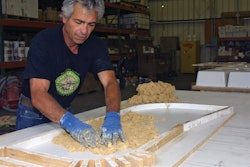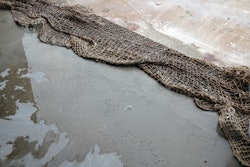In the last two columns we have examined both the PART 1 - GENERAL and PART 2 - PRODUCTS portions of a specification; and in this column we will examine the PART 3 - EXECUTION portion of a specification. PART 3 includes articles related to the on-site installation, erection, and application of the materials, products, components, equipment, and assemblies specified in PART 2.
3.1 EXAMINATION. Includes the requirement that the substrates on which work is to be performed should be examined for compliance with requirements and other conditions affecting performance. Work should not proceed until unsatisfactory conditions have been corrected in a manner complying with the Contract Documents. Starting work on a substrate means the conditions of the substrates have been accepted.
3.2 PREPARATION. Includes preparatory requirements that are necessary before the work can proceed. Surfaces should be made ready for the work to take place. This includes surface cleaning, repair of defects, and evaluation of the surfaces to determine if the surfaces are ready for subsequent work. Field testing for quality assurance may be required.
3.3 [ERECTION][INSTALLATION][APPLICATION]. Includes the requirements for the incorporation of the work onto previously completed work. This might include performance requirements and quality standards such as industry and trade association standards that should apply to the work. While it is not necessary to repeat manufacturer’s installation instructions in the specification, it is necessary to include salient information that bears on the work that is unique to the project. It is important that the specification does not include means and methods of construction since this is the contractor’s responsibility. Attachments and anchorage of products should also be specified. Installation tolerances should also be included.
3.4 REPAIRS/RESTORATION. Includes how existing work should be repaired, restored, or cleaned.
3.5 FIELD QUALITY CONTROL. Includes testing and inspection of products conducted on-site to determine if the work is in compliance with the contract documents; may be further subdivided into the following:
1. Tests and inspections
2. Non-conforming work
3. Manufacturer services
4. Coordination of other tests and inspections
Also includes manufacturer’s field inspection where a representative of the product manufacturer visits the site to determine if the work is proceeding according to the manufacturer’s designs, recommendations, instructions, and warranty requirements.
3.6 ADJUSTING. Includes requirements for start-up adjustments that may be necessary before the building is occupied and used for its intended purposes. Post-occupancy adjustments may also be included.
3.7 CLEANING. Includes procedures for final cleaning of the installed work to make it ready for owner acceptance.
3.8 CLOSEOUT ACTIVITIES. Includes operational demonstrations to designated personnel, training for maintenance of surfaces and products, training of designated personnel on how equipment operates, and training on how to clean and care for installed products. Also might include information on the types of information that should be retained for record documents.
3.9 PROTECTION. Includes procedures for protecting the installed work for the remainder of the construction period until acceptance by the owner.
3.10 MAINTENANCE. Includes provisions for the maintenance of the work for a specified period of time after substantial completion. This is especially important for transition of equipment from the contractor control to owner control.
So we have now completed our brief examination of the anatomy of a specification and have explored the contents of the three parts that comprise most specifications. Specifications are used to compliment the drawings and communicate a particular scope of work and you should now have a basic understanding of the information and requirements that is contained within a specification.



















